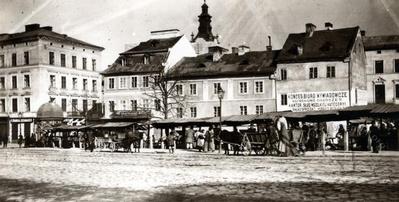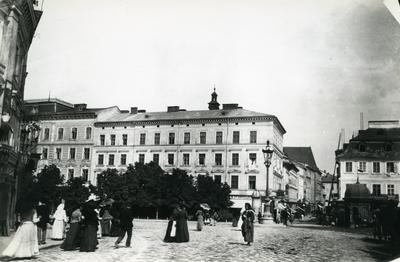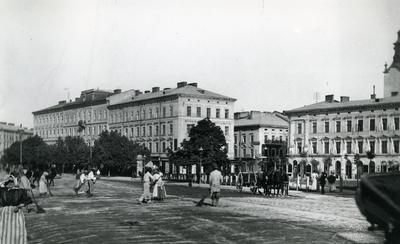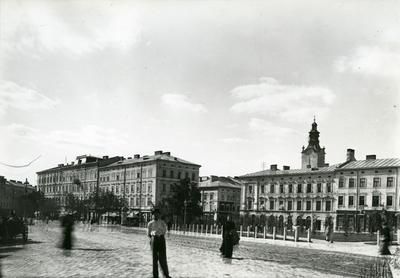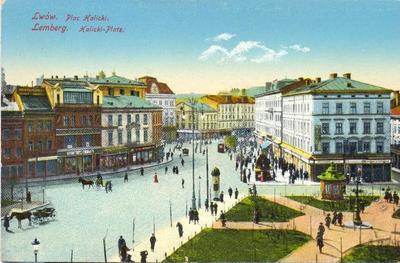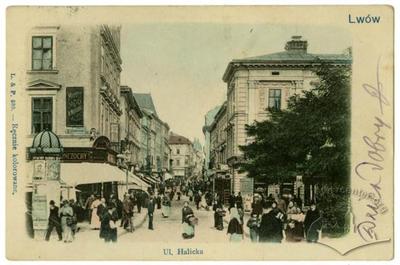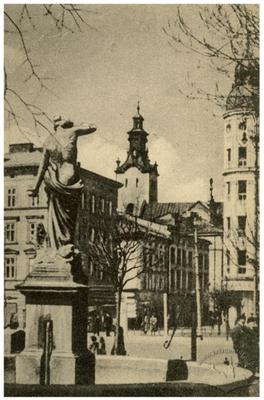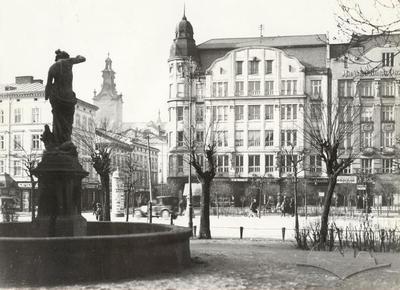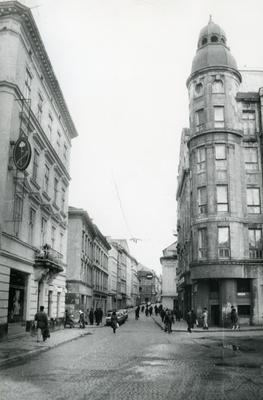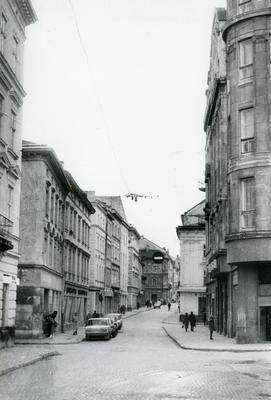Vul. Halytska, 20 – residential building ID: 1245
The house on Halytska street 20 (old conscription number 330, new conscription number 299) was built in place of the former defensive ditch behind the Halytska gate, in front of the guardhouse. According to the resolution of the Lviv city executive committee number 130 dated 26 February 1980, the house was entered in the local register of monuments under protection number 65-M. Today the ground floor premises are rented by various owners for commercial activities; in particular, “Emporio” clothes shop and a bank are situated there.
Story
1787 – a stone house is built on a plot (55 ells long, 27 ells wide) in the ditch of the southern side of the town fortifications.
1789 – a common wall with the house on Valova street 2 is constructed.
1803 – a new stone house in place of the old one constructed in 1787 is built; it has been preserved up to the present day.
2nd half of the 19th c. – the house is reconstructed; the fourth floor is added and a tin roof with a belt of little roof windows is made.
The house (old conscription number 330, new conscription number 299) was built in place of the former defensive ditch behind the Halytska gate, in front of the guardhouse. Its first owner was a furrier and a member of the “forty men collegium”, Stefan Komarnicki (Стефан Комарницький), a descendant of an old Ukrainian family and a member of the Stauropegion Institute from 23 April 1797. Initially Komarnicki owned a plot under conscription number 304 (Halytska street 18) which he bought at a public sale in 1782 and sold to Maciej Krupski in 1790. Before this plot was sold to Krupski, Stefan and Marianna Komarnicki bought from the town another plot in the ditch (55 ells long and 27 ells wide) under conscription number 330, in accordance with a contract of 27 April 1787; in the same year they started to construct a stone house there. As it was usual at that time, Komarnicki transferred it to the possession of his second wife Marianna of the Bojanowski family (his first wife died on 22 February 1772). In 1789 the new house construction was finished when a common wall with Feliks Tribwasser’s house (conscription number 301, Valova street 2) was built; the money necessary for this Komarnicki borrowed from his neighbour Katarzyna Budzinska.
The Komarnickis lived in the newly built house for about ten years. In 1803 Marianna Komarnicka as a rightful owner had a new stone house built in place of the former one which had been dismantled; the reason for this decision is unknown. By the end of that year the construction was not quite finished. On 31 December 1803 architects Klemens Fesinger and Maksymilian von Krus established the following facts: “The front façade plot is 23 Vienna ells wide and 55 ells long and 20 ells away from Lorenz’s house (Valova street 2; the size corresponds to the purchased parcel). The construction of the house on this ground was started anew and has not been quite finished yet. The socle of hewn stone and stone corbels which are to support the balcony over the entrance are made already, apart from the plate and railing. Ceilings with plaster mouldings have been made in the second floor premises as well as in the back rooms; tile stoves have been made in all rooms. The new construction total cost, beginning from the foundations and not taking into account the walls of the previous house, amounts to 12,059 rhenish guldens, 35 kreuzers”. In accordance with a contract of 25 March 1805 between the town and Marianna Komarnicka, the property was transferred to the possession of the latter for 30 years, beginning from 1 September 1804. The date is that of the property inventory. The house was reconstructed in the second half of the nineteenth century. The fourth floor was added and a fireproof roof with a belt of little roof windows was made. Various institutions were housed in the building, in particular, in the early twentieth century one could find there a bureau of count Tomasz Łubieński’s Agricultural House for Commerce and Production (Dom rolniczy dla handlu i przemysłu), M. Csernak’s and A. Pawłowski’s Exquisite Clothe Rolls shop (Bławatne towary łokciowe Csernak M. i Pawłowski A.), Ferdynand Güttler’s small wares shop, Anela Huppert’s children’s clothes shop named “Zsarotka”, Otylia Hilferding’s fashionable goods shop. Feliks Feliński, a tailor, Edward Fisch, a treasury secretary, Zdzisław Stanecki, an accumulator factory owner, lived in the house in 1913. A shop, where various kinds of goods were sold, functioned on the ground floor of the house in the Soviet times. After Ukraine became independent, the ground floor premises have been rented by various owners for commercial activities, in particular, by “Antoshka” children’s clothes shop and now by “Emporio” clothes shop; a part of premises is rented by a bank.
Architecture
The house has four floors; it is rectangular in plan, has three façades and five axes from the side of Halytska street. The house architectural style is that of Classicism. The corner from the side of the square is cut; a figure of St. Florian is placed in a niche at the level of the second floor. The ground floor is decorated with board rustic stones. The main entrance is situated in the middle of the frontal façade; a balcony supported by three white stone corbels with carved heads hangs over it. The upper stories are not divided architecturally; the fourth story is accentuated with a cornice. The windows have profiled framing; the second floor windows are crowned with triangular pediments. The entrance stoop is bridged with a cross vault; the staircase is based on vaulted constructions. The architecture forms of the early nineteenth century have remained almost intact in the house.
People
A. Pawłowski –
a co-owner of M. Csernak’s and A. Pawłowski’s Exquisite Clothe
Rolls shop.
Aniela Huppert – Zsarotka children’s clothes shop owner.
Edward Fisch –
a treasury secretary who lived in the house number 20.
Zdzisław Stanecki –
an accumulator factory owner who lived in the house number 20.
Katarzyna Budzinska –
Stefan Komarnicki’s neighbour.
Klemens Ksawery Fessinger –
a Lviv architect.
Lorenz –
the owner of the house on Valova street 2.
M. Czerniak –
a co-owner of M. Czerniak’s and A. Pawłowski’s Exquisite Clothe
Rolls shop.
Maksymilian von Krus –
a Lviv architect.
Marianna Komarnicka (née Bojanowska) – the
house owner, Stefan Komarnicki’s second wife.
Maciej Krupski –
the parcel owner.
Otylia Hilferding –
a fashionable goods shop owner.
Stefan Komarnicki (Стефан
Комарницький)– a furrier and a
member of the “forty men collegium”, a descendant of an old
Ukrainian family and a member of the Stauropegion Institute from 23
April 1797, the first owner of the house on Halytska street 20.
Tomasz Łubieński –
the Agricultural House for Commerce and Production bureau owner.
Feliks Triebwasser –
the owner of the house on Valova street 2.
Feliks Feliński –
a tailor who lived in the house number 20.
Ferdynand Güttler –
a small wares shop owner.
Sources
- State Archive of Lviv Oblast (DALO) 2/1/2119. The file was renamed: DALO 2/1/1986. URL: https://e.archivelviv.gov.ua/file-viewer/228765#file-836965
- Central State Historical Archive of Ukraine in Lviv (CDIAL) 166/1/895:109, 47.
- CDIAL 166/1/902:438, 164.
- CDIAL 166/1/941:33, 8.
- CDIAL 166/1/1029:491, 383.
- Ksіęga adresowa król. stoł. miasta Lwowa, (Lwów, 1913).
- Володимир Вуйцик, Leopolitana II (Львів: Класика, 2012).
Citation
Oksana Boyko, Vasyl Slobodyan. "Vul. Halytska, 20 – residential building", Transl. by Andriy Masliukh, Lviv Interactive, (Center for Urban History, 2014). URL: https://lia.lvivcenter.org/en/objects/halytska-20/











